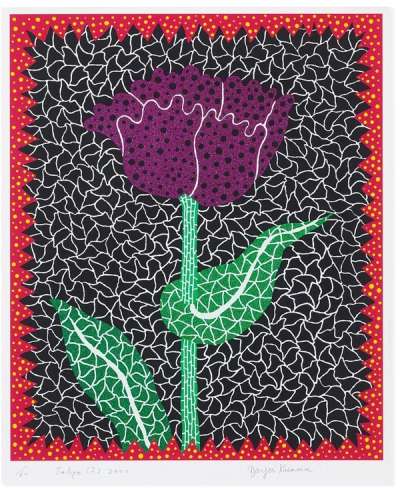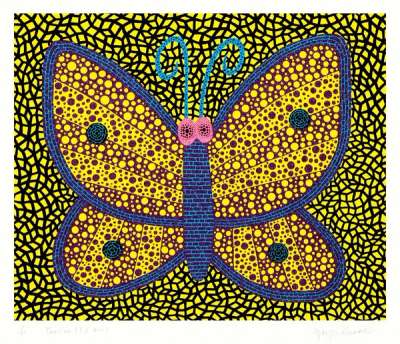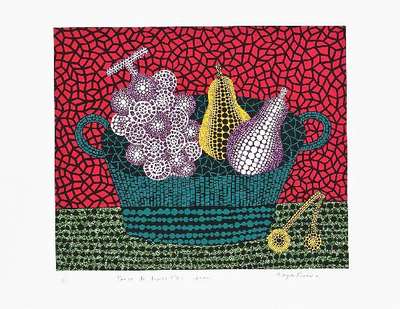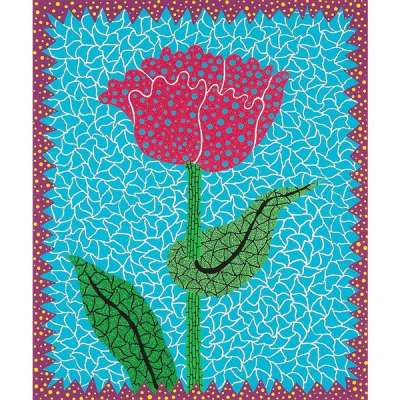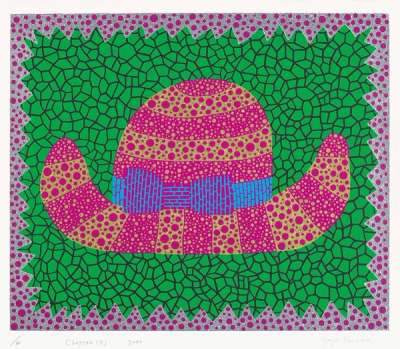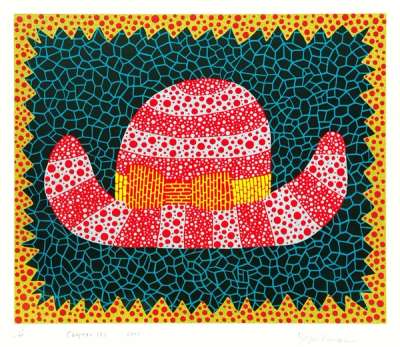Amour
Pour Toujours
Yayoi Kusama’s Amour Pour Toujours (2000) series contains 10 screen-prints in a vibrant palette, comprised of complementary colour combinations. Adorned with Kusama’s polka dots and the Infinity Net pattern which first made waves in New York, the series showcases her most recurrent motifs: butterflies, hats, pumpkins, flowers, and fruit.
Yayoi Kusama Amour Pour Toujours For sale
Amour Pour Toujours Value (5 Years)
Works from the Amour Pour Toujours series by Yayoi Kusama have a strong market value presence, with 109 auction appearances. Top performing works have achieved standout auction results, with peak hammer prices of £61309. Over the past 12 months, average values across the series have ranged from £15900 to £59466. The series shows an average annual growth rate of 16.75%.
Amour Pour Toujours Market value
Auction Results
| Artwork | Auction Date | Auction House | Return to Seller | Hammer Price | Buyer Paid |
|---|---|---|---|---|---|
 Papillon I, Amour Pour Toujours Yayoi Kusama Signed Print | 27 Sept 2025 | K Auctions | £13,600 | £16,000 | £19,000 |
 Citrouille I, Amour Pour Toujours Yayoi Kusama Signed Print | 22 Mar 2025 | Shinwa Art Auction | £29,750 | £35,000 | £40,000 |
 Citrouille II, Amour Pour Toujours Yayoi Kusama Signed Print | 8 Feb 2025 | Mainichi Auction, Osaka | £25,500 | £30,000 | £35,000 |
 Tulipe I, Amour Pour Toujours Yayoi Kusama Signed Print | 19 Oct 2024 | Mainichi Auction, Osaka | £18,700 | £22,000 | £26,000 |
 Chapeau I, Amour Pour Toujours Yayoi Kusama Signed Print | 2 Dec 2023 | Ravenel, Taipei | £11,050 | £13,000 | £17,000 |
 Chapeau II, Amour Pour Toujours Yayoi Kusama Signed Print | 29 Oct 2022 | SBI Art Auction | £34,000 | £40,000 | £45,000 |
 Papillon II, Amour Pour Toujours Yayoi Kusama Signed Print | 22 Jan 2022 | Mainichi Auction, Osaka | £29,750 | £35,000 | £40,000 |
 Panier De Fruits I, Amour Pour Toujours Yayoi Kusama Signed Print | 9 Dec 2021 | Mallet Japan | £25,500 | £30,000 | £35,000 |
Sell Your Art
with Us
with Us
Join Our Network of Collectors. Buy, Sell and Track Demand
Meaning & Analysis
Published as a portfolio in 2000, Yayoi Kusama’s Amour Pour Toujours comprises 10 screen-prints in a bold palette, accompanied in the original portfolio by a poem by Alain Jouffroy in its original French. The prints gather five of Kusama’s most recurrent and beloved motifs— butterflies, hats, pumpkins, flowers, and fruit baskets—with each motif featuring in two prints by the same design, but in different colourways.
Where Kusama’s art is often recognisable by a limited palette of two highly contrasting colours—for example black and yellow, as is common in her Pumpkin sculptures—Kusama colours Amour Pour Toujours with a larger palette of five or six colours per print. She frequently pairs complimentary colours within designs, placing pink and green adjacently in Chapeau II, for example, making the colours ‘pop’ with vibrancy through their opposition.
Papillon I is a work that truly exemplifies Yayoi Kusama’s oeuvre. It is dominated by her signature yellow, electrifying when paired with black in an Infinity Nets style background. This choice of pattern is itself an acknowledgement of key moments in the artist's career; first exhibited in New York in 1959, shortly after her move to the city in 1958. The print's were widely admired for their controlled reimagining of New York's Abstract Impressionism, which was the inspiration behind both Yayoi Kusama's emigration and the net pattern itself.
The print depicts a butterfly with playful simplicity: composed centrally, the butterfly is shown flattened, with spiral antennae and bulbous eyes, such as a child might draw. Not only does the print encapsulate Yayoi Kusama’s visual style, through its colour, playful simplicity and use of dots, Papillon I reflects Kusama’s interest in honouring Japanese tradition. In Japanese culture, butterflies are believed to carry mortal souls as they leave the living realm. Thus, as a symbol of metamorphosis, they are vibrant yet fragile representatives of Japanese culture, much like the artist herself.
Yayoi Kusama has frequently spoken about using art for its metamorphosis-inducing power. Her use of polka dots throughout her art, for example, is a means of coping with her experiences of hallucination, which, as a child manifest in the form of terrifying visions of bright lights, spots and other obliterating patterns. Stating also that, ‘our earth is only one polka dot among a million stars in the cosmos’, her dots and her art more broadly are a means of grounding the self in what could otherwise be a frightening existential realisation. Much like her dots, then, her butterflies represent the artist’s universe-encompassing spiritual beliefs, which she embodies in her life and art.
Yayoi Kusama’s spiritual outlook is at once bleak and peaceful: likely, this belief system stems not only from an awareness of Japanese spiritualism, but also from a troubled childhood in which she clashed with her mother and experienced deeply unsettling and perspective-shifting mental illness. While today her paintings frequently sell for millions at auction, her mental health has pursued her through success. Having first made peace with her diagnosis of obsessive-compulsive disorder through her artistic practice, Kusama checked herself into a Tokyo psychiatric hospital where she has lived since the ‘70s. Her peaceful, destigmatized, and self-actualised attitude towards life and existential realities is embodied in Amour Pour Toujours; with its notable joie de vivre the portfolio embodies Kusama’s rare stoic personality, and celebrates everyday objects while using them as symbols in a vast, enlightened spirituality.
